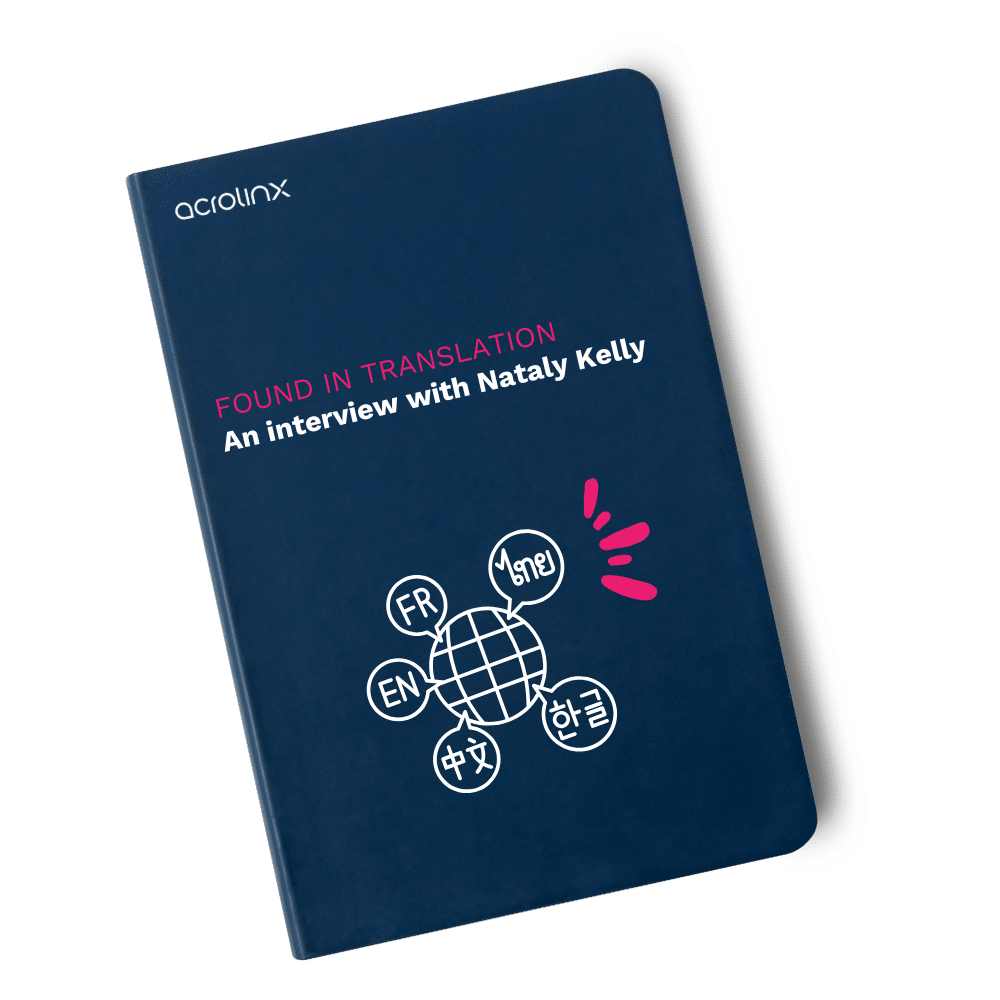Why Translatability Is Crucial For Technical Documentation And Beyond

What does translatability mean?
From a scientific standpoint, it means “the capacity of expressing the content of a source language (SL) text into a target language (TL) text.” For corporate content, the definition can be expanded:
Translatable content has qualities that make translation efficient and thus keep costs low, while maintaining high content quality.
Is translation part of your content strategy? If yes, in how many languages is your content translated into? The more languages, the more global your audience is. And the more critical it’s to create perfectly translatable source content to guarantee smooth translation processes — and streamline the quality of the output.
Why translation matters
According to a study by One Hour Translation, 48% of Fortune 500 companies don’t offer translated content on their website. Talk about a missed opportunity! While these numbers have probably changed over the years, we’re sure there are still organizations that don’t translate their website content. These organizations are missing out on various possibilities. Let’s explore four of them now.
Entering new markets
Translation allows organizations to break down language barriers and make their products and services accessible to a wider audience. By translating product documentation, website content, and marketing collateral, companies can effectively connect with potential customers in different regions. This helps drive international expansion and revenue growth.
Building a better global image
By communicating with international audiences in their native languages, companies demonstrate cultural sensitivity and a commitment to understanding diverse markets. This fosters a positive brand perception and builds trust and credibility on a global scale.
Improving customer engagement
Translation makes information readily accessible and understandable for a diverse, global audience. Businesses are able to interact with customers in their preferred language. This strengthens relationships, improves customer satisfaction, and increases loyalty.
Improved accessibility and inclusivity
Translation makes content available to individuals who may not be proficient in the original language of this content. By offering translated content, organizations can cater to a wider audience, including those with diverse language backgrounds or limited language proficiency.
In essence, the impact of translation goes beyond language barriers, playing a vital role in business expansion, brand reputation, customer engagement, and inclusivity. It’s an indispensable tool for companies seeking to thrive in today’s interconnected and diverse global marketplace.
Who needs content translation?
In today’s highly globalized world, a better question would be: Which organizations don’t need to translate their content? While translation is crucial for almost all enterprises, across industries and locations, small, local businesses are an exception. Imagine a local cake shop which doesn’t even have its own website. Long term, even these exemplary businesses might evolve, looking for a broader customer base, or opening new subsidiaries, and subsequently run into the need of offering some translated content.
Ultimately, wherever there’s content, there’s a need for translation, either now or in the future.
Why high source text quality is key to successful translation
For successful content translation, you need to make sure your source texts are of high quality.
How to write easily translatable source texts
Translation quality refers to the content quality of the translated copy. For translated text to be of high quality, source text needs to follow some important rules. Make sure your content is:
- Clear: Clear content minimizes ambiguity, making it easier for translators to convey the original meaning accurately.
- Consistent: Consistent use of language and terminology throughout a text leads to readable translations and lowered translation costs.
- Correct: Both human translators and AI translation tools will be confused by errors, leading to translation issues and longer feedback cycles, which is why flawless spelling and grammar are crucial for good translations.
- Terminologically correct and consistent: Consistently using correct terminology makes sure your specialized terms are consistently translated across different languages, reducing the chances of errors or misinterpretations.
Why does source text quality matter?
Decreased ambiguity
High source text quality is especially important if you work with external translators, translation services, or use machine translation software. All of these translation resources rely on accurate information without potential ambiguities, in order to provide correct translations without the need of clarifying open questions about the source text.
Lower translation costs
High-quality source text reduces the need for multiple reviews and revisions during the translation process, caused by content errors. Also, a high-quality source text helps to avoid ambiguity and misunderstanding, resulting in a more precise and efficient translation process. Both reduce the time and effort required for translation, ultimately leading to lower costs. Also, keep in mind that consistent source texts lower the risk of obsolete translations.
Example: Consider working with a translator who uses a translation memory. If a writer creates a new sentence which differs from an already translated one by only one term, it counts as a new sentence that needs to be translated. If the writer instead sticks to the preferred term, the translator can find the sentence in translation memory and doesn’t need to translate it. The organization would save the costs for translating the new term. This might seem very rigid, but looking at a larger scale, organizations can save lots of money with consistently used terminology.
Legal compliance
In many industries, accurate translation is essential for meeting legal and compliance requirements. From contracts and regulatory documents to terms and conditions, making sure that these materials are accurately translated is critical for business operations and maintaining legal compliance in international markets.
Other tips for guaranteeing translation quality
Turn translation guidelines into guidance
Actionable writing and reviewing guidance is a central success factor for quality translations.
Set up guidelines
You need document guidelines for your source texts. These document guidelines should make sure content adheres to the needed characteristics like clarity, consistency, correctness, and clear and consistent terminology. Also, the guidelines need to take your general corporate writing standards into account.
Make the guidelines available to writers, reviewers, and translators
The best guidelines for translating content are useless, if nobody knows them. That’s why you should make them available to everyone in the translation and overall content processes. This can happen rather manually, via a static style guide, or by using content governance software like Acrolinx.
Take international SEO into account
If you’re translating web content, always consider international SEO. You can’t simply translate your keywords, but you need keyword localization. Analyze which keywords have ranking potential in the language you’re translating into. To do so, analyze the topics, keywords, and context in the final language, to identify the most promising final translation.
Govern AI translation
According to a re:solution survey, “60% of survey takers were unable to distinguish an AT [automatically translated] message from a human one.” Also, the survey showed that 86% of participants trust automatically translated customer service answers. While this is positive news for organizations using machine translation technology, it doesn’t mean we should use AI translation tools without caution. Same as with generative AI for content creation in general, a human in the loop is indispensable to make sure multilingual content based AI translation is correct and aligned with corporate writing standards.
How Acrolinx helps businesses deliver great translations
Being an AI-based content governance software, Acrolinx allows companies to govern both source text and translated content. It digitizes complex, multi-page style guides, turning them into guidance for creating and reviewing various document types like technical documentation, marketing collateral, and compliance documents.
Let’s explore how it works.
Content quality assurance
Acrolinx offers quality checks across multiple dimensions like clarity, tone, terminology, or spelling and grammar. Checks can be conducted manually by writers who create source texts or review finalized translations. The software provides actionable suggestions that are clickable within the writer’s preferred tools.
Acrolinx also offers automation, allowing enterprises to scale content quality assurance. Integrated into translation workflows, Acrolinx’s automation can prevent source documents which don’t meet defined criteria from being forwarded to translation.
AI guardrails for writing standards
AI guardrails for writing standards make sure that this governance encompasses all kinds of multilingual content: Whether it’s human-written or AI-generated content, and regardless of who did the translation, be it a human translator or AI.
Integrations with enterprise translation tools
With integrations across major platforms like Adobe, Microsoft Office, and content management systems, Acrolinx makes sure that your writing standards are consistently applied across departments and regions, even as content scales. This is especially valuable for enterprises with diverse content types and global audiences. Also, you can use Acrolinx with your existing enterprise translation tools. For example, you can import your terminology, which you manage in tools like SDL MultiTerm, into Acrolinx, to check source texts and translated content for these terms.
Content analytics
Acrolinx Reporting ties content quality to performance, offering insights into how well your content resonates with different audiences. This feedback loop allows companies to adjust content strategies and refine guidelines for greater engagement and efficiency.
Curious to learn more about terminology and why it’s so important for high-quality translations? Read our guide to learn more.
Are you ready to create more content faster?
Schedule a demo to see how content governance and AI guardrails will drastically improve content quality, compliance, and efficiency.

Hannah Kaufhold
is a Senior Marketing Manager at Acrolinx, with over ten years experience in content strategy and content creation. They hold a Master’s degree in linguistics. Hannah has a strong interest in controlled languages and terminology and is passionate about diversity and inclusion. In their free time, they enjoy spending time with their family and reading.





